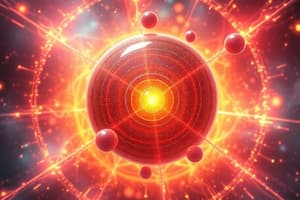Podcast
Questions and Answers
What is the total number of electrons in the 24Mg2+ ion?
What is the total number of electrons in the 24Mg2+ ion?
- 16
- 14
- 10 (correct)
- 12
How many neutrons does the ion 32S2- contain?
How many neutrons does the ion 32S2- contain?
- 16 (correct)
- 18
- 20
- 14
What is the charge of an ion with 3 protons and 2 electrons?
What is the charge of an ion with 3 protons and 2 electrons?
- -1
- 1 (correct)
- 0
- -2
If a neutral atom has an atomic number of 9, how many neutrons does an ion of mass number 19, 19F-, contain?
If a neutral atom has an atomic number of 9, how many neutrons does an ion of mass number 19, 19F-, contain?
What would be the number of protons in a cation 7Li+?
What would be the number of protons in a cation 7Li+?
What particles are considered nucleons in an atom?
What particles are considered nucleons in an atom?
What does the atomic number (Z) of an element represent?
What does the atomic number (Z) of an element represent?
In a neutral atom, how does the number of electrons compare to the number of protons?
In a neutral atom, how does the number of electrons compare to the number of protons?
To calculate the number of neutrons in a neutral atom, which formula is correct?
To calculate the number of neutrons in a neutral atom, which formula is correct?
Which of the following correctly describes the charge of protons and electrons?
Which of the following correctly describes the charge of protons and electrons?
What is the relative mass of an electron compared to a proton?
What is the relative mass of an electron compared to a proton?
Which nuclear symbol correctly indicates 3 protons and 4 neutrons?
Which nuclear symbol correctly indicates 3 protons and 4 neutrons?
What is the correct interpretation of the mass number (A)?
What is the correct interpretation of the mass number (A)?
Flashcards
What are ions?
What are ions?
Atoms that have gained or lost electrons, resulting in a net positive or negative charge.
What are anions?
What are anions?
Negative ions formed by gaining electrons.
What are cations?
What are cations?
Positive ions formed by losing electrons.
How to determine the number of protons in an ion?
How to determine the number of protons in an ion?
Signup and view all the flashcards
How to determine the number of electrons in an ion?
How to determine the number of electrons in an ion?
Signup and view all the flashcards
What is the nucleus of an atom?
What is the nucleus of an atom?
Signup and view all the flashcards
What are protons?
What are protons?
Signup and view all the flashcards
What are neutrons?
What are neutrons?
Signup and view all the flashcards
What are electrons?
What are electrons?
Signup and view all the flashcards
What is the mass number (A)?
What is the mass number (A)?
Signup and view all the flashcards
What is the atomic number (Z)?
What is the atomic number (Z)?
Signup and view all the flashcards
What is a nuclear symbol?
What is a nuclear symbol?
Signup and view all the flashcards
How to find the number of neutrons in an atom:
How to find the number of neutrons in an atom:
Signup and view all the flashcards
Study Notes
Atomic Structure and Ions
- Atoms are composed of protons, neutrons, and electrons.
- Protons and neutrons (nucleons) are located in the nucleus.
- Protons have a positive charge, neutrons are neutral.
- Nucleus is small, dense, and contains most of the atom's mass.
- Electrons have a negative charge and orbit the nucleus in shells/orbitals.
- Most of an atom's volume is empty space.
Subatomic Particle Properties
- Proton: Relative mass = 1, Relative charge = +1
- Neutron: Relative mass = 1, Relative charge = 0
- Electron: Relative mass = 0.0005, Relative charge = -1
Representing Atomic Composition (Nuclear Symbols)
- Mass number (A): Total number of nucleons (protons + neutrons).
- Atomic number (Z): Number of protons, uniquely identifies the element.
- Nuclear symbols concisely represent atomic composition (e.g., ⁷Li).
Determining Subatomic Particle Numbers in Neutral Atoms
- Protons: Equal to the atomic number (Z).
- Electrons: In a neutral atom, equal to the number of protons.
- Neutrons: Calculated by subtracting Z from A.
Ions: Unequal Protons and Electrons
- Ions are atoms with a different number of protons and electrons.
- Anions: Negatively charged ions; have more electrons than protons.
- Cations: Positively charged ions; have fewer electrons than protons.
Determining Subatomic Particle Numbers in Ions
- Protons: Still equal to the atomic number (Z).
- Electrons: Calculated by adding (anions) or subtracting (cations) the ion's charge from the atomic number.
- Neutrons: Calculated by subtracting Z from A.
Studying That Suits You
Use AI to generate personalized quizzes and flashcards to suit your learning preferences.




